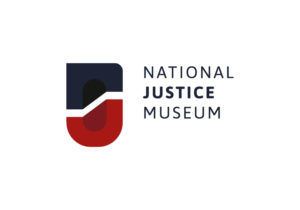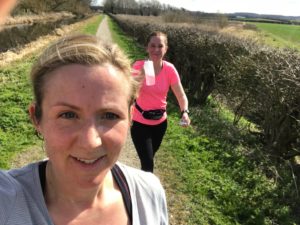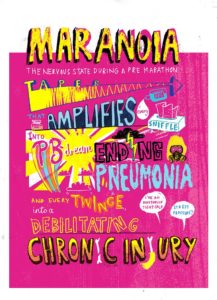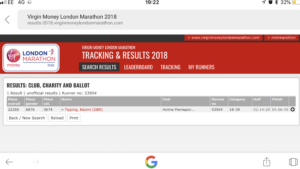Monthly Archives: April 2018
VHS Fletchers are pleased to sponsor Nottingham runner Naomi McArthur. Naomi is to run her first full Marathon this year in London on 22 April to benefit the Help a Child Appeal.
In relation to the marathon itself, Naomi describes herself as:
“excited and terrified in equal measure!”
National Justice Museum’s Help a Child Appeal
Her chosen charity is The National Justice Museum’s Help a Child Appeal. This aims to help children to stay away from crime and understand and engage with their rights while living up to their responsibilities.
Naomi has described her motivation for completing the marathon for the charity:
“As a mum of three, living in the City of Nottingham, I wanted to support a charity which educates local children about the law, and encourages them to become law abiding citizens, and make positive decisions for their futures.”
The money raised helps the charity to provide educational activities for children, who might not otherwise have the opportunity to visit the museum.
How will the donations be spent?
The funded activities will help broaden the horizons of the children who take part in the program. They encourage self-motivation, self-confidence and engagement. Young people who attend will be able to develop a range of essential skills.
These include critical thinking, debate, presentation, research and analytical skills, as well as speaking, listening and communication skills.
Any donations can help children feel empowered to:
- Learn about the law
- Stay away from crime
- Make positive decisions
- Be more tolerant of others
- Develop aspirations for their future
In 2015/16 over 22 000 young people took part in one of the charity’s educational activities. With continued help, the charity aims to continue to reach out and provide opportunities for even more. Any donations made will have a direct impact on the children and young people that the charity works with.
Update
On Friday 23 February Naomi held a fund raiser at Suede Bar in Nottingham.
This was a great success, with a total of 115 tickets sold. 600 raffle tickets were also sold for a great array of prizes donated by individuals and local business. After expenses an impressive total of
£1600
was raised for the charity.
Naomi had recovered sufficiently by the Sunday to take on a 16 mile run, enjoying the sunshine before the Beast from the East hit.
On Tuesday Naomi didn’t let the snow keep her indoors, and we have photographic evidence to prove it.
Unfortunately, Thursday‘s planned 18 mile run was frustrated by too much snow as the Beast from the East struck and schools were closed. Instead Naomi took to the exercise bike.
We’ll post further updates when we have them. Click on the links below to show your support (moral and financial).
Update 2 – 16 March 2018
Since we last updated you on Naomi’s progress towards the London Marathon she has undertaken a 16 mile run from East Midlands airport to Nottingham Castle. Here she is contemplating a flight out of the country rather than doing the run.
158 people took part in the run. The cause on this occasion was to raise money for the UK Bowel Cancer charity.
Here is Naomi at the finish. With five weeks to go, she has an 18 mile run planned for tonight.
Naomi has also been asking people to guess her finish time with the incentive of a cash prize, with time ranging from 3:42:10 to ‘did not finish’. It’s £1 a guess, and she’ll ask you when she sees you.
Update number three – 3 April
Naomi enjoyed her longest run ever in the sunshine on Sunday 25 March. This was 22 miles along the Grantham Canal. She was dropped off in Harby and left to run home!
Another 20 miles just 4 days later was tough going on her legs, so Naomi is very happy that it’s now time to taper off. She is slightly disappointed that the taper is not a little more drastic as there is still over 100 miles to run, with two more long runs of 15 and 10 miles respectively as the date of 22 April approaches.
Update number 4 – 17 April
 That’s it now, Naomi has completed her training. The t-shirt has been printed. Only five more sleeps to go. Despite popping echinacea supplement and bingeing on oranges, “maranoia” has well and truly taken hold!
That’s it now, Naomi has completed her training. The t-shirt has been printed. Only five more sleeps to go. Despite popping echinacea supplement and bingeing on oranges, “maranoia” has well and truly taken hold!
Naomi questions whether she will manage the last 4 miles that she hasn’t covered in training? Will  her bad knee finally give way? Will she melt in the blistering heat of the hottest London Marathon in fifteen years?
her bad knee finally give way? Will she melt in the blistering heat of the hottest London Marathon in fifteen years?
423 miles have been run since January of this year, taking up 66 hours of her time. Over £1700 has been raised so far for the for The National Justice Museum’s Help a Child Campaign.
Despite this, she remains as terrified as she was three months ago!
PS – Update 5 – 19 April
Naomi after 3 miles in the blazing sunshine this evening. 3 MILES in the EVENING!!! She’s wondering whether it’s too late to defer….
Follow the link to give to make this all worth while!
Update 6 – the day after
Despite it being her first marathon, and it being the hottest London Marathon on record, Naomi completed the race in an impressive 4 hours and 56 minutes.
We have asked Naomi for her comments on the day and she offers:
‘It was TOUGH! The hottest London Marathon on record (would you believe it after all that training in the snow, ice and rain?) and the heat 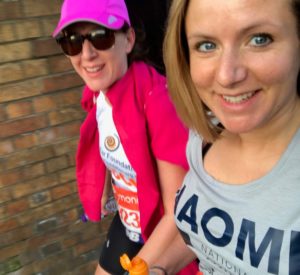 really got to me. I felt unwell really early on, with nausea and dizziness from miles 5 and 6.
really got to me. I felt unwell really early on, with nausea and dizziness from miles 5 and 6.
It was a mental battle of over 4 hours to reach the finish line from there! All ideas of achieving my dream time went out of the window and it just became a case of ploughing on until the finish line.
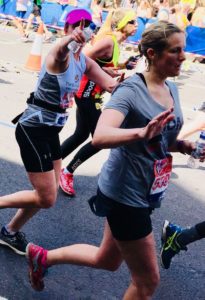 It was so HOT that I questioned whether or not I’d even make it to the finish line at all, but thanks to my running buddy and a great support team I did!
It was so HOT that I questioned whether or not I’d even make it to the finish line at all, but thanks to my running buddy and a great support team I did!
I’m feeling proud but broken today, and very happy to have raised nearly £2000 for a great cause.’
Although Naomi has vowed ‘never again’ as she stumbled across the finish line, she is left wondering what she might be capable of in better conditions.
Its not too late to donate. Follow the links below.
You can look back at Naomi’s progress towards the Marathon and her fundraising drive on her Facebook page here.
The link to make a donation can be found here.
Monthly Archives: April 2018
There is a specific offence of dangerous driving, which carries a maximum prison sentence of 2 years. If that driving is a cause of someone’s death, that maximum sentence unsurprisingly increases to one of 14 years. A more recent offence of causing serious injury by dangerous driving was created in 2012 and carries a maximum sentence of 5 years in prison.
In each case there are minimum disqualification periods and very lengthy actual disqualifications which involve the passing of a mandatory re-test before a driver can return to the road. Insurance premiums which will remain significant for many years to come, with some drivers unable to secure insurance at all, at any price.
What is dangerous driving?
Dangerous driving is defined by section 2A Road Traffic Act 1988:
“…a person is to be regarded as driving dangerously if (and, subject to subsection (2) below, only if)—
(a) the way he drives falls far below what would be expected of a competent and careful driver, and
(b) it would be obvious to a competent and careful driver that driving in that way would be dangerous.”
There is also a further element of dangerous driving related to unsafe vehicles, although this is not within the scope of this article.
The test is an ‘objective one’ which means that it is not to be judged through the eyes of the actual driver but the eyes of a ‘competent and careful driver’. As a result it, in any trial, it will be for a magistrate, District Judge or jury to decide on guilt.
The crucial part of the test is that the driving falls ‘far below’ the standard expected. It is this aspect of the offence that, on occasion, makes advising in these cases such a highly skilled task.
In some cases it will be immediately obvious that the driving falls ‘far below’ the standard of a competent and careful driver. For example, if a person is driving at 100 mph on the wrong carriageway of the motorway at night without lights, then there is no room for debate.
But some case are more difficult. What if, believing that you have sufficient sight of the road ahead, you overtake only to hit an oncoming vehicle in the opposite lane. Would that fall into the category of driving ‘far below’ the standard, or it is simply an unfortunate error of judgement, and one that could perhaps be properly categorised as careless rather than dangerous driving?
No statutory definition exists of driving falling ‘far below’
There is no statutory definition of what is meant by ‘far below.’ Section 2A(3) of the 1988 Act states that “dangerous” must refer to the danger of personal injury or serious damage to property.
Case law also makes it clear that the driver’s particular skill or lack of is not relevant as set out in Bannister [2009] EWCA Crim 1571.
A full exploration of the circumstances of the alleged offence will be required in borderline cases. The Crown Prosecution Service regards the following as being examples of dangerous driving:
- racing or competitive driving;
- failing to have proper and safe regard for vulnerable road users such as cyclists, motorcyclists, horse riders, the elderly and pedestrians or when in the vicinity of a pedestrian crossing, hospital, school or residential home;
- speed, which is particularly inappropriate for the prevailing road or traffic conditions;
- aggressive driving, such as sudden lane changes, cutting into a line of vehicles or driving much too close to the vehicle in front;
- disregard of traffic lights and other road signs, which, on an objective analysis, would appear to be deliberate;
- disregard of warnings from fellow passengers;
- overtaking which could not have been carried out safely;
- driving when knowingly suffering from a medical or physical condition that significantly and dangerously impairs the offender’s driving skills such as having an arm or leg in plaster, or impaired eyesight. It can include the failure to take prescribed medication;
- driving when knowingly deprived of adequate sleep or rest;
- driving a vehicle knowing it has a dangerous defect or is poorly maintained or is dangerously loaded;
- using a hand-held mobile phone or other hand-held electronic equipment whether as a phone or to compose or read text messages when the driver was avoidably and dangerously distracted by that use (R v Browning (2001) EWCA Crim 1831, R v Payne [2007] EWCA Crim 157);
- driving whilst avoidably and dangerously distracted such as whilst reading a newspaper/map, talking to and looking at a passenger, selecting and lighting a cigarette or by adjusting the controls of electronic equipment such as a radio, hands-free mobile phone or satellite navigation equipment;
- a brief but obvious danger arising from a seriously dangerous manoeuvre. This covers situations where a driver has made a mistake or an error of judgement that was so substantial that it caused the driving to be dangerous even for only a short time. Cases that illustrate this principle include where an offender failed to stop at a junction where there was a give way sign, failing to see a taxi that was being driven across the junction perfectly properly and colliding with it; offender unintentionally pressed the accelerator instead of the brake; offender drove across a junction marked by a give way sign and collided with a car that was being driven along the major road and had no explanation for his failure to see the other car.
It should be stressed, however, that ultimately it will be a matter for the court to decide.
Cases of dangerous driving less than clear cut
Some of the examples in the above list may seem surprising, for example where a person unintentionally pressed the accelerator instead of the brake. It is worth repeating that much will depend on what actually happened. Argument may well be possible around concepts such as ‘…even for only a short time…’
Similarly, argument can be raised about when a breach of a legal duty in ‘…failing to have proper and safe regard…’ strays over the line from being careless driving to an incident of dangerous driving?
A lawyer will need to try and dilute the very real risk of judging everything from the perspective of hindsight and the outcome of the driving.
Legal strategies to defend dangerous driving cases
In stressful situations, particularly where serious harm has been caused, there is an instinctive reaction to think that the driving error must also have been very serious.
Standing back, as lawyers, we know that the truth is that on occasion even the slightest error can result in very serious consequences. It is therefore vital that if you are to be interviewed by the police following an accident that you secure legal representation at the outset.
All of our legal advice and assistance at a police station or any other place will be free of charge to you as a suspect regardless of your financial means. You can read more about the help we can give here. The scheme also operates if you are not under arrest but being spoken to on a voluntary basis. This does not mean that the police are treating the allegation any less seriously and more information can be found here.
Accident investigation and reconstruction is now an important consideration in many cases. This allows scientists and engineers to see exactly the cause(s) of an accident and the magnitude of error, often exposing the culpability of others. Such reports can be expensive, but help will be available if you are eligible for either Magistrates or Crown Court legal aid.
Eye-witness testimony is not always reliable and is also often tainted by the result of the driving as opposed to the driving itself. This will need to be exposed through expert cross examination of the witnesses in court.
In some cases there may still be some room for manoeuvre and a plea to the lesser offence of careless driving may be appropriate.
How we can assist you if you face dangerous driving allegations
Whether an act of driving amounts to dangerous driving is often not easy to ascertain. Our experienced lawyers routinely deal with all manner of driving cases, from the minor to the most serious.
Whether facing imprisonment or not, the loss of a driving licence is for many people an incredibly serious penalty in itself. We will take all steps possible on your behalf to avoid that happening.
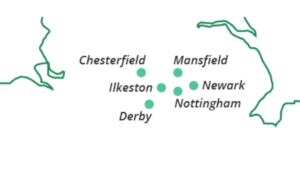
We have six offices across the East Midlands and provide advice and provide nationwide advice and representation. Find your nearest office here. Alternatively use the contact form below.
Contact
Monthly Archives: April 2018
Following on from the revelations about failures in disclosure identified last year, on 3 April The Times published further information about the scale of the failure by the police and 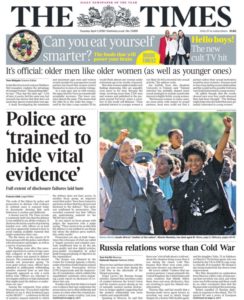 prosecution to disclose evidence vital to fair trials. It is claimed that the failure to disclose such key evidence is both routine and deliberate, including hiding evidence within sensitive material schedules.
prosecution to disclose evidence vital to fair trials. It is claimed that the failure to disclose such key evidence is both routine and deliberate, including hiding evidence within sensitive material schedules.
These reports are against a background of interest in the criminal justice scheme, including a BBC Survey, the publishing of a Charter for Justice and a campaign to send every sitting MP a copy of the recently published book by the Secret Barrister about the crisis in the criminal justice system.
A dossier has been produced that draws on the reports of a number focus groups held with the police, prosecutors and judges. The file also includes the results of a survey of prosecutors. It was obtained by the charitable organisation The Centre for Criminal Appeals.
Helpful evidence hidden on sensitive material schedules
The research has identified a commonly held view that the defence is not entitled to see evidence that might undermine the case against an accused. Tactics are adopted by the police to stop it being handed over. At least one force trains its officers to hide such material in a ‘sensitive material’ schedule which means the defence are unlikely to discover that is exists and disclosure may well be avoided.
One comment from a police focus group was ‘If you don’t want the defence to see it, then [evidence] goes on the MG6D’, this list of ‘sensitive material’.
A prosecutor is quoted as saying that ‘In even quite serious cases, officers have admitted to deliberately withholding sensitive material from us and they frequently approach us only a week before trial. Officers are reluctant to investigate a defence or take statements that might assist the defence or undermine our case”.
Material should only appear on a sensitive material schedule where the disclosure office believes its disclosure ‘would give rise to a real
risk of serious prejudice to an important public interest.’ The reason for that belief should also be stated, and the officer must sign off on the schedule.
It is envisaged that such sensitive material will not just be that which helps the defendant. Instead, examples are:
- material relating to national security;
- material received from the intelligence and security agencies;
- material relating to intelligence from foreign sources which reveals sensitive intelligence gathering methods;
- material relating to the identity or activities of informants, or undercover police officers, or witnesses, or other persons supplying information to the police who may be in danger if their identities are revealed;
As a result it is unlikely to include evidence that simply points to the innocence of a defendant.
Prosecution also at fault in disclosure decisions
However fault is also identified on the part of prosecutors. Sometimes this is due to the volume of cases, in combination with a lack of time to do the job properly, poor quality police investigations and the pursuit of ‘wrong’ priorities.
It remains to be seen whether the new Director of Public Prosecutions who will replace Alison Saunders when her contract expires in the autumn will have the resources to effect any meaningful change.
Instruct VHS Fletchers to ensure adequate disclosure
A judge within one of the focus groups observed, ‘There seems to be an idea that the defence is not entitled to see things but where the defence press matters, this yields results.’
As a result, until the culture changes and more resource is made available, to a great extent an accused will be dependent upon their  lawyer identifying whether material is likely to exist and make an appropriate application for disclosure.
lawyer identifying whether material is likely to exist and make an appropriate application for disclosure.
Our team of experienced Crown Court litigators and advocates will ensure that disclosure in any particular case is meaningful, rather than, as one prosecutor put it, ‘more of an administrative exercise‘.
You can read about two recent cases where our requests for disclosure made a difference here and here.
Find your nearest office here or use the contact form below.



